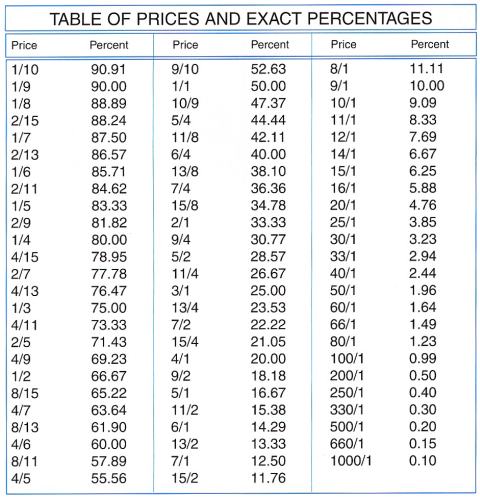Although many punters are reticent to dabble in multiple bets in the one race, there is a case to be made out for such an approach being a winner.
Like everything else in racing, it needs to be carefully controlled.
Every punter needs to know about the percentages and odds-and-chances. They mean the same thing expressed in a different way.
They form the basis of the maths of betting and give you a clear idea as to whether the bookmaker has too much in his favour with the prices he's offering.
From our point of view, we can use the figures to back two or more runners in a race. This is the crux of overlay betting.
My colleague Brian Blackwell uses such an approach with his excellent ImpactPro ratings on the PPD Club (www.practicalpunting.com.au). As an example of the success he's been enjoying, let's take a glance at the recent Railway Stakes in Perth, in which Northerly was a very shortpriced favourite.
ImpactPro rated him a 3/1 chance, so he was definitely a 'NO BET' proposition because the value just wasn't there (assuming that ImpactPro had got it right). The program's second selection was Old Comrade, priced at 5/1. This was THE bet.
Old Comrade was available at more than 7/1 (TAB) and landed the money. Thus, followers of ImpactPro knew that Northerly was no value but Old Comrade was, and they got the money.
This is an example of how the percentages can work in favour of the punter. It won't happen all the time, but it does happen enough times to make you a profit, provided that your assessments are accurate.
You can play around a lot with the approach. For example: Let's say you have FIVE horses in a race that you want to back. Using the overlays-only approach you would back only those selections which offered a better price than your assessed price.
If you are not into overlays, you could still back the five, provided the prices enabled you to do so. In this example, then, let's say the horses are:
ROAN 3/1
RED 9/2
BLACK 4/1
WHITE 8 / 1
GREY 9/1
You decide you want to "save" on Black, White and Grey and go for an equal win on Roan and Red.
The quickest formula to arrive at the amount of the insurance bets is to add ONE to the price and divide it into the full bank to be invested on the race.
In this instance, say, we will be betting $100.
To find the bet on Black we divide 5 (4+1) into $100; the result is $20.
On White, we divide 9 (8+1) into $100; the result is approximately $11, while on Grey the bet is the division of 10 (9+1) into $100, which is $10.
Our book now reads:
$80 to $20 BLACK
$88 to $11 WHITE
$90 to $10 GREY
A win by any of those three runners will return us $100.
We've now invested $41 of our $100 bank, which leaves us $59 to be bet on Roan and Red in such a way as to return an equal amount.
We follow the same procedure as before. Roan is 3/1, which represents a 25 per cent chance. Red is 9/2, which indicates an 18.2 per cent chance.
This gives a grand total of .432, so our bets will be as follows:
ROAN $59 multiplied by 250, divided by 432
RED $59 multiplied by 182, divided by 432
This, to the nearest dollar bet, is $34 on Roan and $25 on Red, the bets being as follows:
ROAN $102 to $34
RED $112.5 to $25
Our investment now totals $100. A win by either White, Black or Grey will square the bank.
Success by Red or Roan will bring in approximately $136/$137, and provide us with a profit on the entire transaction of $36 or $37.
By using the bookmakers' percentages table, punters are able to assess the percentage operating against them in any given race.
The bookmaker sets his prices so that potentially he's able to "lay" the amount of his book against all runners and show a profit no matter which horse wins.
Naturally, he's not always able to lay the field but he strives to do so and always frames his prices to put the percentage against the punters.
In a field of four, a bookmaker decides to bet to, say, a 10 per cent profit. His quotes might be:
Horse A: Evens
Horse B: 2/1
Horse C: 5 / 1
Horse D: 9/1
For a $100 book he would seek to lay:
A: $50 to $50
B: $66.70 to $33.30
C: $83.30 to $16.70
D: $90 to $10
On that book, he would hold $110 to pay out $100, so no matter which runner wins, the bookie wins $10.
If you want to use the table for betting, the procedure is obvious. Maybe you trim a race down to three key chances, Tiger 3/1, Lion 4/1 and jumbo 8/1.
You want to back all three to win the same amount. Look at the table and you'll see that you would bet $25 Tiger, $20 Lion and $11 Jumbo, a stake of $56 for a potential return of $100.
On the above example, you might decide to "save" on Tiger and Jumbo and go for the bigger win bet on Lion.
You want to bet $10 on the race. You invest $2.50 on Tiger (25 per cent), $1 on jumbo. A win by either will return you $10. After these two bets totalling $3.50 you have $6.50 left, which is bet on the other horse, Lion, at 4/1.
If Lion wins, your return is $32.50, for a profit of $22.50.

Click here to read Part 1.
Click here to read Part 2.
By Richard Hartley Jnr
PRACTICAL PUNTING - JANUARY 2002